
Moths are a group of insects that includes all members of the order Lepidoptera that are not butterflies. They were previously classified as suborder Heterocera, but the group is paraphyletic with respect to butterflies and neither subordinate taxa are used in modern classifications. Moths make up the vast majority of the order. There are thought to be approximately 160,000 species of moth, many of which have yet to be described. Most species of moth are nocturnal, although there are also crepuscular and diurnal species.

Lymantria dispar, also known as the gypsy moth or the spongy moth, is an Eurasian species of moth in the family Erebidae. Lymantria dispar is subdivided into several subspecies, with subspecies such as L. d. dispar and L. d. japonica being clearly identifiable without ambiguity. Lymantria dispar has been introduced to several continents and is now found in Europe, Africa, Asia, North America and South America. The polyphagous larvae live on a variety of deciduous and coniferous trees and can cause severe damage in years of mass reproduction. Due to these features, Lymantria dispar is listed among the world's 100 worst invasive alien species.

The Tortricidae are a family of moths, commonly known as tortrix moths or leafroller moths, in the order Lepidoptera. This large family has over 11,000 species described, and is the sole member of the superfamily Tortricoidea, although the genus Heliocosma is sometimes placed within this superfamily. Many of these are economically important pests. Olethreutidae is a junior synonym. The typical resting posture is with the wings folded back, producing a rather rounded profile.

Saturniidae, members of which are commonly named the saturniids, is a family of Lepidoptera with an estimated 2,300 described species. The family contains some of the largest species of moths in the world. Notable members include the emperor moths, royal moths, and giant silk moths.

Campaea margaritata, commonly known in the UK as the light emerald, is a moth of the family Geometridae. The species was first described by Carl Linnaeus in his 1767 12th edition of Systema Naturae. It is widely distributed throughout Europe, the Near East and North Africa. The habitat is mixed forests including parks and large gardens.

Pterophorus pentadactyla, commonly known as the white plume moth, is a moth in the family Pterophoridae. It is found in the West Palearctic including North Africa and Europe. The wingspan is 26–34 mm (1.0–1.3 in). It is uniformly white, with the hind wing pair divided in three feathery plumes and the front pair in another two. The moths fly from June to August. The larvae feed on bindweed.
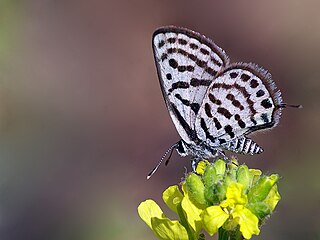
Tarucus balkanicus, the Balkan Pierrot or little tiger blue, is a small butterfly that belongs to the lycaenids or blues family. It is found in Mauritania, Niger, Sudan (Khartoum), Uganda, Saudi Arabia, the United Arab Emirates, Oman, North Africa, the Balkans, western Asia, parts of central Asia and in India. The habitat consists of very arid savanna.

Rhodometra sacraria, the vestal, is a moth of the family Geometridae. The species was first described by Carl Linnaeus in his 1767 12th edition of Systema Naturae.

Dioryctria sylvestrella, the new pine knot-horn or maritime pine borer, is a moth of the family Pyralidae. It is found in Europe, parts of Asia and North Africa. The adult is a small mottled brown and white insect with a wingspan of 28 to 35 mm. The moth flies in a single generation from June to October and is a pest of maritime pine and several other species of pine, on which the caterpillars feed.

Emmelina monodactyla is a moth of the family Pterophoridae found in Africa, Asia, Europe and North America. It was first described by Carl Linnaeus in 1758.

Palpita vitrealis, common name jasmine moth or white pearl, is a species of moth of the family Crambidae.
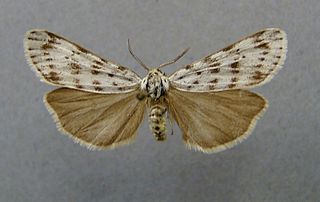
Coscinia cribraria, the speckled footman, is a moth of the family Erebidae. The species was first described by Carl Linnaeus in his 1758 10th edition of Systema Naturae. It is found in Europe except the most northern parts; also in north-western Africa, Kazakhstan, Siberia, Mongolia, north-western and north-eastern China.

Hydriris ornatalis, the ornate hydriris, is a moth of the family Crambidae. It has a wide distribution and is known from southern Europe, Asia, Australia, Africa and North America, where it is restricted to Florida.

Evergestis frumentalis is a moth of the family Crambidae. It is found from the Iberian Peninsula through southern and central Europe and southern Fennoscandia to central Asia and southern Siberia. The species was first described by Carl Linnaeus in 1761.
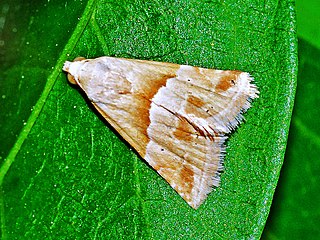
Eublemma parva, the small marbled, is a moth of the family Erebidae. The species was first described by Jacob Hübner in 1808.

Lamoria anella is a species of snout moth described by Michael Denis and Ignaz Schiffermüller in 1775 found in Africa, Asia and Europe.
Mecyna trinalis is a species of moth in the family Crambidae. It is found in France, Spain, Italy, Austria, the Czech Republic, Slovakia, Poland, Hungary, the Balkan Peninsula, Ukraine, Russia, Turkey and North Africa, including Algeria and Morocco.
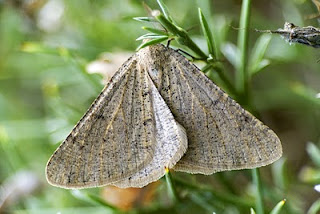
Isturgia miniosaria is a species of moth in the family Geometridae. It is found in France, Spain and Portugal. It is also found in North Africa, including Morocco.
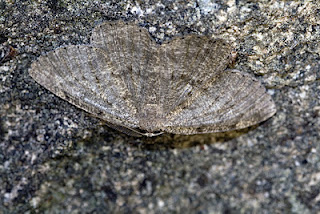
Gnophos dumetata, the Irish annulet, is a species of moth in the family Geometridae. It is found in large parts of Europe, except Great Britain, Portugal, the Benelux, Switzerland, Bulgaria, Fennoscandia and the Baltic region. It is also found from north-western Africa to Armenia, Dagestan, and the south-western part of the former Soviet Union.

A MONA number, or Hodges number after Ronald W. Hodges, is part of a numbering system for North American moths found north of Mexico in the Continental United States and Canada, as well as the island of Greenland. Introduced in 1983 by Hodges through the publication of Check List of the Lepidoptera of America North of Mexico, the system began an ongoing numeration process in order to compile a list of the over 12,000 moths of North America north of Mexico. The system numbers moths within the same family close together for identification purposes. For example, the species Epimartyria auricrinella begins the numbering system at 0001 while Epimartyria pardella is numbered 0002.



















